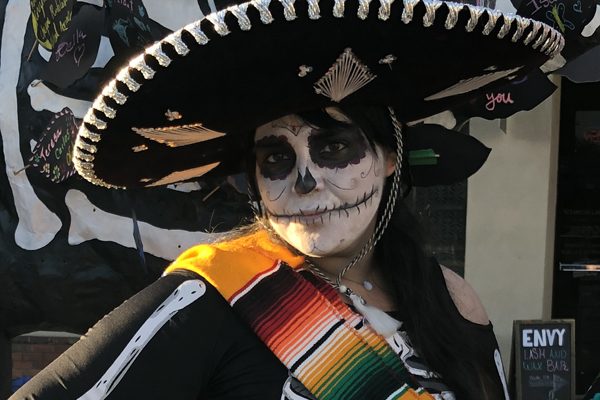The start of a new year, whether it’s celebrated Jan. 1 or on some other date, often is accompanied by some form of ceremony or tradition, no matter where in the world a person happens to be, according to the Old Farmer’s Almanac, a publication that dates to 1792.
Many of these traditions resemble each other, such as loud noises, lucky foods or beverages, or other practices.
Ringing in the new year still takes place in Italy, where church bells chime at the stroke of midnight. Other places that still have bells in houses of worship or government buildings often ring them at midnight as well.
But other countries use different sounds to mark the new year. Firecrackers are used in China as a remembrance of a time people thought they’d chase away evil forces. In Thailand, guns were used to frighten away demons as well.
Colonial Americans also used firearms to mark the beginning of the new year.
Suriname’s fireworks include those that produce long red ribbons, and those with the longest ribbons are sought out at stores.
Australia’s fireworks in its largest city, Sydney, are legendary, with synchronized pyrotechnic shows that includes a display called the “Bridge Effect” that displays symbols and other images related to the current year’s theme in
In Japan, bells ring 108 times, the number of mental states that can lead people to act inappropriately.
Two Pacific island nations, Kiribati and Samoa, are the first countries to mark the arrival of the new year.
Many people have a glass of champagne ready for toasting at midnight. Some say the clink of the glasses are like a bell peal, and make the toast a full-sensory experience – the sight of the bubbles, the smell and taste of the champagne, the feel of the glass and finally the sound of the glasses.
But in the Netherlands, the new year is welcomed with hot, spiced wine, and a spiced “hot pint” is used to toast friends’ prosperity. Wassail is substituted in some Celtic parts of the world.
In many countries, circular foods are eaten to mark the “full circle” of an old year passing and a new one beginning. In Italy, lentils and sausage slices are eaten because they look like coins, a sign of prosperity in the new year.
In Germany, a small pig made of marzipan is eaten for good luck. People go door to door to neighbors’ homes, where they are served Speckdicken, a pancake-like dish with dark syrup, summer sausage and bacon.
In North and South Korea, the special food is a hot soup served with thin, flat rice cakes. Those missing out on the soup are considered unlucky. But round items, from polka dot patterns to round fruits and sweets are symbols of coins and are considered fortunate.
Denmark residents used to have traditional meals of cod, stewed kale and cured pork, but those foods are giving way to beef and sushi.
A “king’s pie,” with a coin baked inside, is made by Greek families. At midnight, the home’s lights are extinguished and all close their eyes until the new year arrives, when lights are turned back on and so people can enter the new year in the light. Then they serve slices of the pie, and the person who gets the coin is considered lucky for the rest of the year.
Portugal’s dessert is Bolo-Rei, or King’s Cake, with a crown of fruit. Instead of a coin, the Portuguese hide a fava bean, and the person finding that prize has to buy next year’s cake.
In Estonia, people gather for multiple meals, with seven, nine or 12 on New Year’s Eve considered lucky. But some food must be left over – gifts to ancestral spirits that may stop by the house that night.
In Finland, people melt a bit of lead in a small pan on the stove, then drop it into a bucket of cold water. Its shape is analyzed and used to predict what the new year might be like – although the predictions are considered mere fun, and not to be taken seriously.
In the Philippines, eating chicken at New Year celebrations is considered unlucky, because the way poultry scratch and peck is a reminder of a hand-to-mouth existence.
In Spain, Costa Rica, Guatemala and several other countries, people eat 12 grapes, one at a time, during each chime of a clock at midnight. Those grapes represent 12 good wishes for the new year.
In the American South, people eat black-eyed peas and park to assure good fortune, and in Irish communities, people are served bannock pastries.
Rice promises prosperity in India and Pakistan, and in Switzerland, whipped cream symbolized the same. But bits of whipped cream aren’t eaten – they’re dropped on the floor and left there.
While some countries leave the gift-giving for Christmas, other places celebrate New Year’s Day with presents. Gilded nuts and coins are given in Rome and other parts of Italy.
In old Persia, before the country became Iran, people exchanged eggs, a symbol of fertility. And Egyptians once exchanged clay flasks. In modern Egypt, the new year is celebrated by smashing glass bottles.
The Scots have traditions of giving coal, shortbread and silverware. Another Scottish custom is “putting your best foot forward.
After midnight, friends and family members visit each other’s’ homes in that country. And the “first foot” to cross the threshold after midnight will be an indicator of the next year’s fortune.
It’s considered good luck in Scotland for a “first footer” to be a new bride, a new mother or a tall and dark person as well as those who celebrate their birthdays Jan. 1.
In a similar tradition in Russia, if the first person crossing the threshold is male, it is supposed to bring good luck.
In many places, people don new clothing on the first day of the new year, another sign of having a fresh start.
In Nigeria and Ghana, some attend church services on New Year’s Eve, but others party at nightclubs instead.
In Ecuador, men put on dresses and wigs, pretending to be the widow of the year that is passing. They take to the streets, and drivers are forced to give up some coins to the “widows” to pass through the streets.
Central Asian nations that once were part of the Soviet Union continue that former country’s tradition of patriotism, with national anthems played at midnight and governmental officials making appearances.
For those south of the equator, New Year’s Eve and Day are summer holidays, and in Brazil, it marks the beginning of summer holidays. In Chile, people wear yellow clothing, believed to restore vitality.
Many people make New Year’s resolutions, but that custom isn’t new. It dates to the ancient Babylonians, possibly as far back as 2,600 years before the birth of Christ.
People in some countries use the new year’s arrival as a time to contemplate, take stock and, in some cases, literally “turn over a new leaf.”
Some older churches offer “watch night” services, a custom that dates to 1770 at the Old St. Georges Methodist Church in Philadelphia, Pa., as well as churches of the Moravian Brethren tradition. Watch Night took on an additional layer of meaning as people anticipated Jan. 1, 1863, when President Abraham Lincoln announced he was signing the Emancipation Proclamation.
At one time, New Year’s Eve was called Old Year’s Day and is still celebrated as St. Sylvester’s Day, named for a fourth-century pope and saint who witnessed Emperor Constantine I’s conversion to Christianity.
New Year’s Day is observed as a day to honor the Virgin Mary.
In some countries, customs encourage people to start the year with a clean house and all debts paid. In Belgium, unmarried women who don’t finish their work by New Year’s Eve won’t be married in the new year.
Among other sayings advise kissing the person one hopes to keep kissing, or filling pockets and cupboards before midnight to assure abundance in the new year,
Traditions also advise watching the weather, with one saying that describes the year change like the month of March – if it comes in storming like a lion, it will depart as calm as a lamb.
Another Farmer’s Almanac saying suggests that if New Year’s Eve has a night wind that blows south, it is the promise of warmth and growth in the future.


